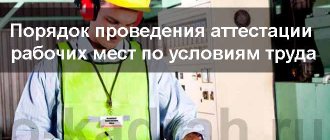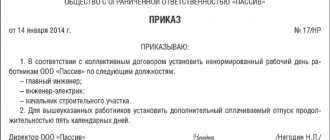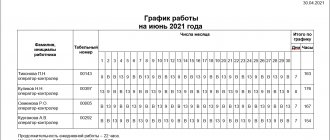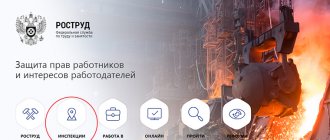In 2021, issues related to the implementation of SOUTH at enterprises are becoming very relevant. This is due to the fact that 5 years have passed since the entry into force of the law on the mandatory implementation of special labor safety measures - the period during which the results of a previously conducted assessment of the quality and safety of working conditions under the previously valid legislation were taken into account. According to Valery Korzh, who holds the position of director in the Department for Safety and Labor Protection of Workers of the Ministry of Labor of the Russian Federation, in 2020, enterprises will be inspected to determine the availability of the results of the special labor safety assessment. Although it is immediately planned to only send out warnings about violations of the law, this may later threaten enterprises with sanctions in the form of fines.
What should be understood by SOUT
A special assessment of working conditions is a whole complex of measures carried out one after another aimed at identifying dangerous and/or harmful factors in the production environment and assessing the degree of their impact on the employee, taking into account the actual values of their deviations from the standards approved by the Government of the Russian Federation for the organization of safe working conditions.
Federal Law dated December 28, 2013 No. 426-FZ classifies almost all workplaces at enterprises, organizations, firms into a category for which it is mandatory to evaluate the working conditions provided to employees according to a special scheme, with the exception of the following cases.
For which categories of employees is it allowed not to carry out a special procedure for assessing the provided working conditions for employees (clause 3, article 3 of the Federal Law of December 28, 2013 No. 426-FZ)
- employees working remotely;
- workers working from home (homeworkers);
- workers whose employers are not individual entrepreneurs;
- workers whose employers are religious organizations.
In addition, there is a legally established list of individual places of work in enterprises with certain types of activities that have specific properties, for which a special procedure must also be carried out to assess the proposed working conditions for workers (Resolution of the Government of the Russian Federation dated April 14, 2014 No. 290 ). Carrying out a special procedure for assessing the impact of working conditions on an employee in such cases is carried out taking into account those features that are established by the authorized body of the federal executive power.
List of enterprises (departments) that carry out certain types of activities, when conducting a special procedure for assessing the impact of working conditions of workplaces on employees where the features established by the federal executive body apply:
- Vessels:
– sea;
– river;
– inland navigation vessels;
- engaged in fishing.
- Civil aviation vessels.
- Organizations providing emergency (specialized) care.
- Intensive care units, intensive care units, operating rooms.
- Departments of medical institutions for performing diagnostics and direct treatment using special medical equipment (instruments, devices, equipment, etc.).
- Organizations that prepare for sports competitions.
- Media, theaters, circuses, etc.
- Enterprises with nuclear and radiation hazardous industries.
- Enterprises related to organizing the work of divers.
- Enterprises whose activities are carried out in the field of extreme exposure to the gas environment and air environment.
- Enterprises associated with underground work.
- City passenger transport.
- Medical departments providing assistance to patients with mental disorders.
- Enterprises that operate in the areas of manufacturing, testing, processing, disposal and storage of explosives.
How to compile a list of workplaces for carrying out SOUT?
The Special Assessment of Working Conditions (SAL), which replaced workplace certification in 2014, made noticeable adjustments not only to the approaches to the procedure, but also to the process of assigning benefits and guarantees based on its results. During the active conduct of special assessments at Russian enterprises, it was possible to accumulate considerable law enforcement practice and make many court decisions of various directions. But cases of non-compliance with legal requirements within the framework of special assessment work still remain quite common. Expert organizations are to blame for many miscalculations, but most of them are made by employers and commissions for the implementation of SAW at the very early preparatory stage.
How to compile a list of jobs for SOUT?
Approval of the list of workplaces subject to SOUT, indicating similar workplaces, is a task of paramount importance for the commission. As practice shows, difficulties arise precisely at this stage. The reason lies in the calculation of the number of jobs by position (with the same titles and several employees). In accordance with Art. 209 of the Labor Code of the Russian Federation, a workplace means a certain space occupied by an employee, or where he needs to arrive to perform job duties, which is under the direct or indirect control of the employer.
Quantitative calculations
To perform error-free calculations, it is necessary to understand how many workers are involved in one workplace at the same time. If an organization employs 3 accountants at the same time in the same temporary mode, without shifts or rotations, then 3 jobs for the position “accountant” are included in the list of jobs for the SOUT.
If we are talking about 4 security guards working in the “every day after three” mode (4 workers replace each other - there is only one guard at the workplace at a time), the list for SOUT reflects only one workplace in which 4 people work in shifts. Most often, errors occur when adding workplaces with the same name, equipment, premises, as well as non-stationary workplaces, especially those with shift or rotational work, to the list. You can avoid miscalculations by adhering to a simple rule - the number of workplaces is equal to the number of employees simultaneously working on it. For example, 6 milling operators work in 2 shifts on 3 machines in one workshop. During the shift, each milling operator alternately works on all three machines, which means that 3 jobs are included in the list. If they meet certain criteria, these jobs can be recognized as similar, which will minimize expenses on special equipment.
To simplify the preparation of the list of workplaces, members of the SOUT commission equate the number of pieces of equipment to the number of workplaces. This approach may be appropriate in some situations, but it will be wrong if:
– one employee uses more than one piece of equipment; – two or more workers use the same equipment at the same time.
The same can be said about non-stationary workplaces, the work areas of which may change geographically. Non-stationary workplaces with the same name cannot be regarded as one workplace.
Name of workplace for SOUT
Correctly entering the names of jobs into the list is as important as the correct number. According to the instructions approved by Order of the Ministry of Labor of Russia dated January 24, 2014 No. 33n, the name of the position in the documentation for a special assessment of working conditions must completely coincide with its counterpart recorded in the staffing table of the enterprise.
It happens that the commission, for reasons of trade secrets, provides the expert organization on SOUT with a list of jobs that does not correspond to the original staffing table. However, in the process of further application of the results of the special assessment when assigning benefits and guarantees, it turns out that not all jobs were covered by the special assessment.
In such situations, inspections may turn into legal proceedings, leading to the conclusion that the implementation of the special assessment system is incomplete due to the lack of information on individual positions. Such oversights can only be avoided by carefully monitoring the coincidence of the names included in the SOUT materials with the positions recorded in the current staffing documents.
The same problem is often faced by organizations that undergo restructuring to optimize their business. The process, as a rule, is associated with changes in job titles without noticeable changes in working conditions and job responsibilities.
Many employers do not see any reason in this situation to conduct an unscheduled SOUT. But they are mistaken, since the names of positions in the list of SOUT often do not coincide with their counterparts in the new staffing table and other documents.
Let us consider cases of incorrect merging and inclusion of jobs in the materials of the SOUT using the example of court proceedings in case No. A59-2617/2015 of the Fifth Arbitration Court of Appeal. The fishing organization carried out a job certification procedure for the “watch mate” workplace, without taking into account the fact that the current staffing table also included the positions of first, second and third mate of the watch captain.
Within the framework of the SOUT, these workplaces were recognized as one and the same workplace. To confirm this circumstance, the expert organization that carried out the assessment activities wrote a corresponding letter. However, the court did not accept the justification of the employer and the expert organization due to the lack of assessment materials on the jobs of the first, second and third watch mate.
The final conclusion of the court decision indicated that there was no legal basis for distributing the results of workplace certification to “positions with similar or identical job responsibilities available in the staffing table,” since such a possibility is not provided for by the Procedure for Certification and SOUT.
Organizations for which frequent change is the norm face more complex challenges. Even in the process of carrying out the special operational assessment, they have to adjust the staffing schedule many times. Experts recommend that members of the special assessment commission and occupational safety engineers of such organizations must necessarily bring to the attention of management the financial consequences of the reforms they are carrying out.
They should know that in accordance with Federal Law No. 426-FZ, for each new position an extraordinary special assessment is required within six months from the date of its introduction. In principle, any changes in the staffing table related to the name of the position are grounds for conducting a special assessment outside the schedule.
Similar jobs
At the final stage of drawing up the list of places where the SOUT will be carried out, it is necessary to determine the correspondence of the names and number of workplaces to the signs of similarity, which will significantly save money on the procedure.
Conducting special assessment procedures is mandatory only for 20% of the total number of similar workplaces (but not less than two). The results obtained apply to all similar workplaces. For workplaces recognized as similar, a general special assessment card of working conditions is drawn up and a unified list of actions is developed aimed at improving working conditions and protecting personnel.
In Art. 9 of the Federal Law on Special Assessment sets out the following characteristics of similar places:
– having the same names; – location in one or several similar rooms (work areas); – equipping with the same communication systems (ventilation, lighting, etc.); – personnel perform the same job duties in the same working mode; – monotype technological processes; – the same equipment, instruments, devices, raw materials and supplies are used; – personnel are provided with the same PPE.
Compliance of similar workplaces with the specified features is mandatory and is determined by the SOUT Commission. The correctness of their determination is established by an expert from an accredited organization carrying out the special assessment procedure. Even a single workplace that does not comply with all the features set out in Federal Law No. 426-FZ is a reason for conducting a special assessment of all workplaces that were found to be similar.
Knowing several rules will allow you to create a correct list of jobs for SOUT:
1. The list of jobs is prepared exclusively on the basis of the current staffing table. 2. The same number of jobs and workers simultaneously performing their job duties. 3. Workplaces with different names (including those slightly different from each other) and similar or identical job functions are different workplaces. 4. Similar are jobs that meet all the criteria set out in Art. 9 of Federal Law No. 426-FZ.
Compliance with the above requirements guarantees a successful result.
What happens if the company does not carry out SOUT
According to SOUT expert, researcher at the central laboratory for examining working conditions at the All-Russian Research Institute of Labor of the Ministry of Labor, Natalya Byshova, it is more profitable for an employer to carry out SOUT than to ignore it, since otherwise he will face a number of financial sanctions.
Carefully reading the legislation (from Part 2 of Article 5.27.1 of the Code of Administrative Offenses) we can see that organizations (enterprises, firms, etc.) that ignored the implementation of special assessment and assessment procedures may be subject to penalties in the amount of 50.0 to 80, 0 thousand rub. In addition, already in the current year, 2021, the employer will not have legal grounds to provide employees with compensation for work with harmful working conditions, since they are accrued only based on the results of a special assessment.
Tax deductions due for the payment of workers' compensation will not be available to an employer who has not conducted a SAW on its enterprise.
The employer’s responsibilities also include indicating in the employment contract with the employee or in an annex to it in the form of an additional one, the working conditions of what level of safety correspond to a specific workplace, the basis for which can only be the results of the conducted special labor safety assessment. These violations entail new fines and amount to 80.0 thousand rubles. It won't work anymore. The amount of fines will significantly exceed the specified amount.
And in any case, if it is discovered that there is no SAW, the employer will be required to carry it out and, accordingly, spend money on it.





